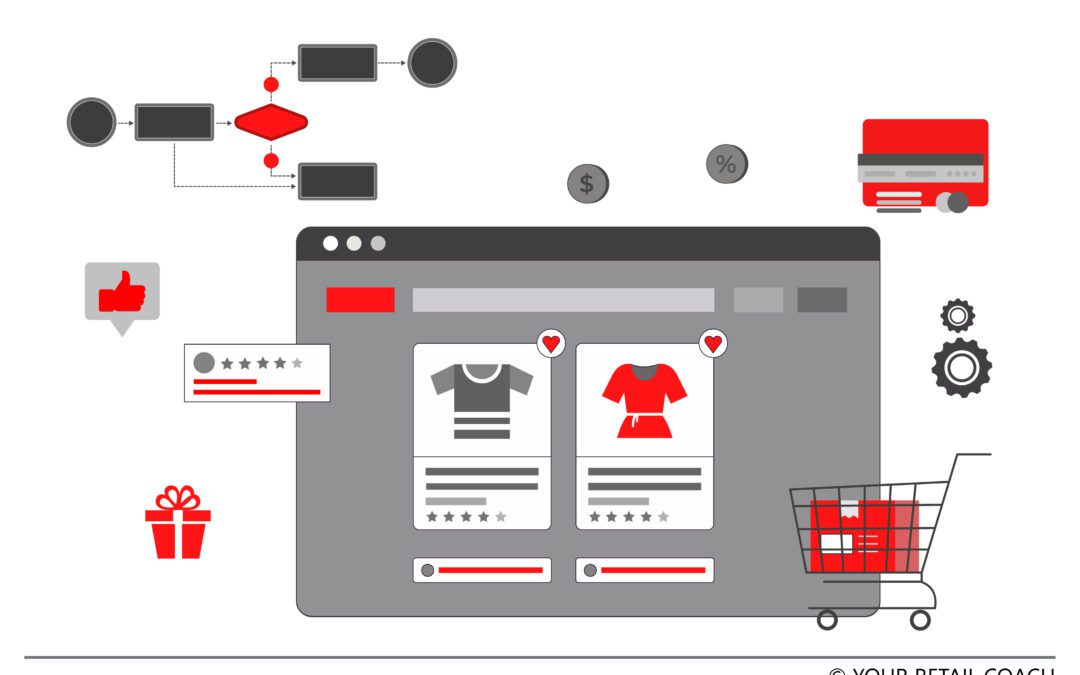Fashion, ECommerce, and SOPs went to a bar…….
If you are planning to start an online fashion business, you must be planning for a lot of things – business modelling, development of the business plan, technology, manpower, suppliers, etc. And if you have not already, include SOP-based operations planning in your list. It is imperative to have a strong operational plan that will define how your business processes and operations will lead you to achieve your business objectives. For instance, you must have a short and hassle-free yet reliable examination procedure for handling product returns. While doing so you must also bear in mind certain things. Speedy purchase is one of the reasons why customers prefer eCommerce. So, you have to make sure that your return process does not violate this requirement. Then, the most common reason for product return (exchange) of fashion merchandise like apparel or footwear is size mismatch. So, at the time of initiating product returns, you need to ensure that the required sizes are available so that customers can choose the right sizes. Although this is a technological and inventory-related aspect it very well forms a part of the SOPs.
In this blog, we will examine different facets of formulating SOPs for online fashion businesses with practical examples with inputs from our experience as business process consultants.
Good Objectives and Poor Processes
Lack of Availability of Products and Timely Delivery
There are many causes why a clothing business may fail to make the right merchandise available in the right quantity at the right time. These comprise inaccurate demand forecasts, untimely procurement of inventory/stock, sluggish operations in warehouses/FCs/distribution centres, lack of logistical planning, etc. It hampers sales and revenue and results in failed chances to serve customers and boost customer confidence. And the root cause of this is the lack of process orientation in executing the business operations. For example, in carrying out demand forecasting, having an established process for the same helps ensure that no vital parameter or statistics is missed out from the equation. In making procurement decisions also, a planned process helps ensure that work is timely triggered for initiation, purchase amounts are appropriately identified, the right approvals are obtained, all the concerned departments/teams are duly communicated so that they can play their role, etc.
Product Returns
Returns may include final merchandise, products under processing, or raw supplies. At any phase in the value chain, a product may be reverted to its previous link in the supply chain for not fulfilling the compulsory standards. For instance, customers may return products due to product defects, damages during logistics and handling, or unmet customer expectations (quality, sizes, etc.) Product returns also cause unnecessary space consumption in FCs and warehouses, additional costs such as reverse logistics, increased workload of delivery teams and other staff employed in the FCs/distribution centres/warehouses, etc. And faulty outputs emerge from poor industrial processes, lack of a strong Quality Management System (QMS), poor packing and handling procedures, poor storage standards, and poor return management.
Managing Multiple Channels
With omnichannel emerging as an effective strategy to supply to a wider customer base, more and more fashion brands are embracing this new standard. In omnichannel processes, tasks like inventory control, recruitment, logistics, purchase, warehousing, and distribution have to be planned and performed with high levels of synchronisation. For example, in purchases, ordering has to be optimised to cover the needs of both offline and online channels when ordering from the same dealer. When the goods reach the warehouse/distribution centre, there has to be appropriate segregation for all channels. Incorporating such operational precision is not possible without strong SOP-based processes mapped and defined in advance.
Poor Vendor and Supplier Management
From the supply of workplace stationeries, resources or final products to the completion of outsourced facilities like IT and housekeeping, suppliers and vendors play a dynamic role in keeping a business up and running. This necessitates defining how they interact with a business enterprise for providing the agreed supplies and services. If there is no operational outline for managing their operations and the value they are expected to deliver, it will affect business operations and the results so created. For instance, if there is no provision in the purchase process to stipulate the delivery timelines, suppliers will arrange their business commitments according to their convenience.
Weak Operational Coordination
Every enterprise must create room for operational harmonisation. It will not happen automatically. The operational planning must be done in consideration of how the different functions and teams are connected to different business processes. When these operational connections are broken, it slows down the workflows and creates scope for mistrust, fraud, and mistakes. Blame gaming is rampant in such enterprises where operational coordination is broken. We can use the case of product returns in a fashion business having poor systems and processes. The production team blames the quality team, the suppliers blame the production team, the suppliers return the culpability to the purchasing team, and while all this goes on, the brand takes a beating.
Cost Optimization
Ecommerce altered the pricing dynamics for retail apparel businesses. If you could offer your products cheaper by even a trivial margin with no major change in other factors, the deal is yours. Even a micro-pricing advantage to customers makes enormous differences in sales and revenue. Average business process management (BPM) deprives fashion brands of this opportunity. For example, optimised scheduling of delivery and pick up of inventory based on transport routes can help bring down the costs of handling and logistics. The scheduling activity must be deliberated, planned, mapped, and defined to achieve this objective. If employees in the distribution hubs have no established scheduling procedures to maintain and follow, they will go by their independent judgements that may or may not be in the best interest for the business.
How SOP fashions its way to superior operations
Timely Procurement
We deliberated earlier that because of deprived process management fashion brands and businesses in the apparel industry experience difficulties in making the goods available to their clients and customers. This leads to dents in revenue as well as reputation. To warrant that the procurement task is executed with strategic perfection, Standard Operating Procedures (SOPs) must be followed both in letter and in spirit. Procurement or purchase SOPs define how the decisions and choices will be made and the workflow will take place towards attaining the business and functional objectives of procurement.
Reliable Inventory Control
Some important questions that need to be resolved in inventory management are when should the reorders be commenced, who will raise and authorise the requests for inventory requirements, what should be the reorder quantity, who will check and approve or disapprove the quality of incoming and outgoing goods, etc. There must be a planned order in which these actions must take place. The output of each stage functions as the input for the next stage. For example, if ROQ is not stated in the purchase request raised by the inventory or warehouse team, how will the purchase division know? Or say, if the checks are not done for inward inventory before it goes for processing, the supplier may not accept any complaint on quantity or quality parameters later on.
SOPs can warrant that the right processes are defined and charted in advance following which the flow of events will be as it is intended and required. Today, inventory management is a highly automated business process in every industry. Once the SOPs inventory operations are defined, these are useful as inputs for identifying and customising process automation solutions.
Quality Assurance
Besides providing a pricing lead to customers, eCommerce also elevated the bar of customer expectations in terms of quality, returns and refunds. Safeguarding quality standards has become an authoritative tool in winning customer loyalty. But the crux is that defects should be exceptions, not a norm. QMS SOPs (Quality Management Systems) help apparel and footwear businesses in developing processes where observance of quality standards can be strictly upheld. Quality screens can be easily added and integrated across the supply chain under the regulation of a business enterprise. It reduces the chances of defective or poor-quality goods entering into the supply chain.
Orchestrated Operations in Warehouses and Distribution Centres
Warehouses and fulfilment or distribution centres play the important part of storage and distribution for any business enterprise. These two business functions facilitate the storage and movement of goods. They constitute the physical point of contact between the supply sources and destinations for distribution. How operations are managed in these two places affects both incoming and outgoing inventory. SOPs help ensure that the operations carried out in warehouses and distribution centres are well-orchestrated to meet the various business and functional objectives related to inventory management.
Better Coordination with Value Chain Associates
For an apparel business, value chain associates include all kinds of suppliers and service providers in the value chain as well as for internal operations and maintenance. How these external entities interact with a business enterprise is governed by the policies and procedures agreed in the contracts and agreements. When there is a planned operational system defined by SOPs, it is easier for both businesses and their value chain associates to carry out operations in tune with the agreed terms and conditions. In the absence of a well-defined working mechanism, the standards of performance take a beating. As SOP consultants, we often see such deviations in undefined working systems manifesting in the form of quality concessions, delays in processing payments, miscommunications, frauds and misappropriations, etc.
FAQs
Why develop SOPs for online fashion businesses?
SOPs provide the element of planned certainty to operations planning. This certainty is important to make sure that business operations go as intended. When business operations go as intended, it means business strategies are getting correctly executed (provided these two were synchronised). And for a fashion brand (online or offline), when operations go aligned with strategies, it means moving towards meeting the objectives of many important business goals and objectives – CX, UX, Quality, Production, Procurement, Order Fulfilment, Inventory Management, etc.
Here are some of the biggest reasons why SOPs are so important for an online fashion business:
- Reliable inventory management to ensure the availability of products
- Accurate and timely order fulfilment including delivery
- Securing authenticity without compromising on customer experience in handling product returns
- Efficiently management multiple channels of distribution
- Proper internal coordination
- Proper coordination with vendors and suppliers
- Optimise resource utilisation











